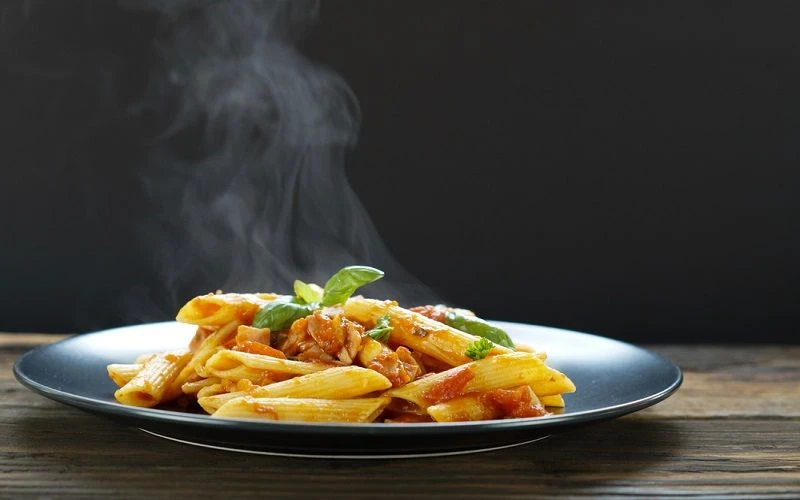by Rick Goldman
There’s no denying that we all enjoy a pasta dish from time to time, after all, it’s one of the most popular foods in the world. Sadly, no one really enjoys pasta once it has been reheated because it tends to resemble rubber, rather than a delicious meal. With that being said, if you’re tired of wasting your leftover pasta dishes because you’re sick and tired of rubbery, sticky pasta, then keep reading to learn about some of the best ways to heat your leftover pasta.
Contents

If you tend to separate your noodles from your pasta, then there’s a good chance that you end up with plain noodles leftover in your refrigerator on occasion. If this sounds like you, check out these simple directions on how to reheat plain pasta.
Making sure that you use enough water to cover up the noodles, boil a pot of water. Make sure that you don’t add in the noodles until the water comes to a boil.
Make sure that you locate a metal strainer that can easily fit into your pot. A strainer that has a long handle would be your best bet for this. We discussed about the best pasta post in another page.
Typically, it only takes about thirty seconds to add some like back into plain pasta. After 30 minutes, remove the strainer from the pot and taste test one of the noodles. If they’re not to your liking, return them to the water for another 15 seconds. Continue to do this in 15-second increments until the noodles are fully done. Also, if you don’t have a strainer with a long handle you can use oven mitts or place the strainer inside of a bowl and pour boiling water over the pasta.
One of the most efficient ways to reheat your pasta is by putting it into the oven. If you’ve never reheated pasta in the oven before, follow these directions carefully and you shouldn’t have any issues doing so.
Before you do anything else, preheat your oven to 350 degrees. Keep in mind, this reheating method is perfect to use for pasta and sauces, but it might not be the greatest or efficient enough for only one serving.
Spread your pasta across the bottom of a shallow dish in an even manner. If you just put it into a pile then there’s a good chance you’ll end up with unevenly heated pasta, which isn’t something that anyone wants to deal with. Also, if your pasta is dry, you might want to add a bit of milk or extra sauce to moisten it up. This is especially important to do if you’re reheating lasagna.
Typically, the pasta will be finished in 20 minutes, but check it after 15 minutes just to make sure. The aluminum foil that you put on top should help trap the moisture, which slows the drying process. Obviously, no one likes dry noodles, so make sure that you don’t forget the aluminum foil. Also, you could add a touch of Parmesan cheese underneath the foil about five minutes before the pasta is done cooking.
Before you take the dish out of the oven, stick a metal fork into the center of the dish and wait 15-20 seconds. If the tip of the fork is hot when you touch it, then your meal is done! If it’s still cold, return the dish to the oven and check it again in another five minutes.
Another efficient way to reheat leftover pasta is to put it on top of your stovetop! This is one of the easiest and quickest ways to reheat pasta, so if you have a limited amount of time on your hands, you might want to try this method out first.
Most pasta dishes can be fried over medium-low heat, so make sure not to set the temperature too high. Once the pan has been heated up, add a little bit of melted butter or oil to the pan. Then, add in the pasta and allow it to cook. Make sure that you stir it every once in a while to prevent it from sticking or burning to the pan. Also, if you think that your pasta looks dry you can always add more pasta sauce into the mix.
Sauces that can easily separate, like cream or wine sauces, must go on low heat. If you’d like to avoid the risk of separation, then you can refer to one of the other methods that we will discuss shortly.
Lasagna is actually one of the best types of pasta to reheat in a frying pan. All you need to do is cut a slice of lasagna and put it into the pan. Make sure to put the cut side down and rotate the lasagna every so often. Once each side is nice and crispy, and the center is hot to the touch, then your lasagna is all done and ready for you to enjoy!
While microwaves aren’t exactly the greatest way to reheat your food, they certainly are efficient in their job.
Because microwaves tend to heat foods unevenly, especially if cheese or veggies are in the dish, it’s important for you to know that you should only reheat single servings in a microwave. This will prevent scalding hot spots and cold noodles from invading your taste buds. Also, if you’re using a cream, wine, or butter, then you might want to reheat it in the oven to avoid separation.
If your leftover pasta already has sauce in it, then make sure that you stir it well to evenly distribute the sauce throughout the entire dish. If you’re working with plain pasta, then it’s time for you to stir in a little bit of sauce or olive oil to keep the pasta nice and moist.
Having the power level set too high will turn your pasta into a pile of mush, so make sure that you reduce the power level down to 50% before you press start.
Put the pasta into a round microwave-safe container, this will avoid uneven heating in the corners, and cover it with one of the following options:
– You can cover your pasta with plastic wrap, but make sure that you leave one of the corners open for steam to be able to escape.
– You can also cover the pasta with a damp paper towel. This allows the pasta to steam while it’s being heated up, which adds extra moisture to dry pasta.
The pasta should be heated up in short spans. So heat it for one minute and then check it. Stir it and if it’s still cold, continue to heat it in 15-30 second increments.
Because of the risk of separation, this is the best way for you to reheat pasta dishes that have a cream or wine sauce.
Because the indirect heat allows for it to cook slowly, this is the best method for sauces like Alfredo.
If you’re able to, you might want to heat the sauce separately, then put the cold pasta on top of it. Leave it here until the water begins to simmer.
Adding in a little bit of fresh milk or cream to cream sauces can help prevent the sauce from separating. If you’re working with a wine sauce, then you might want to add a little bit of butter or reduced cream, instead.
The point of doing this is to slowly heat up the sauce, rather than rushing it. So the lower the heat, the better. Also, make sure that you stir gently to avoid breaking up the different ingredients.
As you can see, reheating your leftover pasta isn’t a difficult task. With a little bit of your time and the right directions, you should have no problem enjoying your favorite pasta dishes for two, or even, three nights!
 |
 |
 |
 |
 |
 |
 |
 |

About Rick Goldman
Rick Goldman's grandpa was a captain of a California coast cruise. This afforded Rick the luxury of traveling to exciting places along the Pacific Coast as a young boy. He got to try different, exotic foods on these journeys - something he really enjoys blogging about from his grandpa's beautiful garden home today.
Check for FREE Gifts. Or get our Free Cookbooks right now.
Disable the Ad Block to reveal all the recipes. Once done that, click on any button below
 |
 |
 |
 |